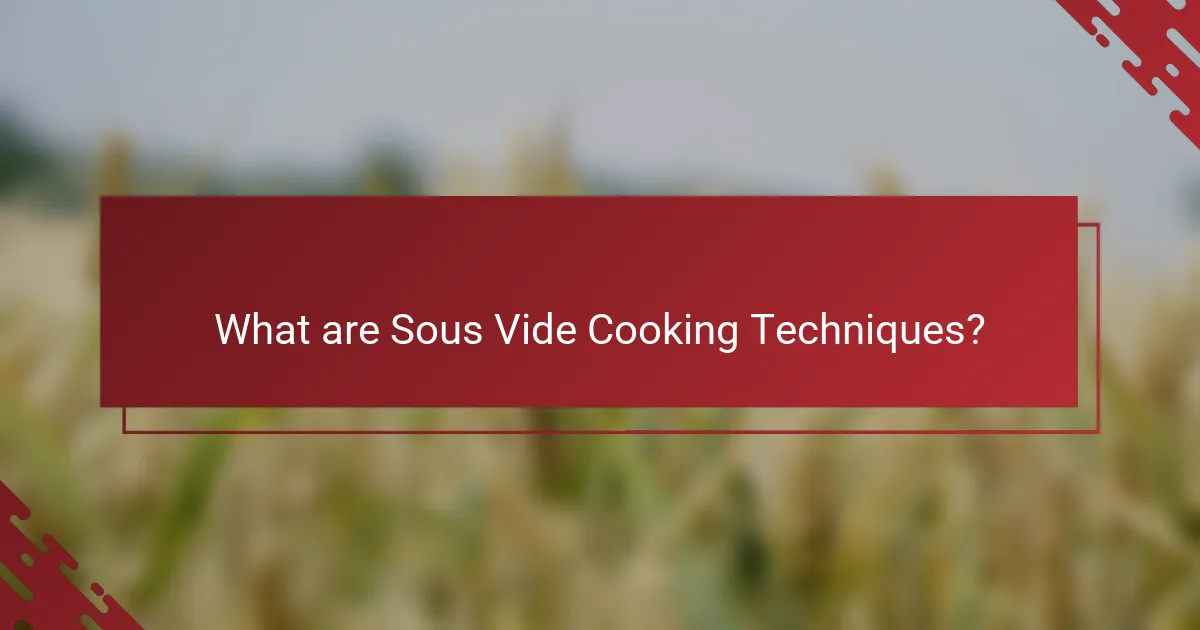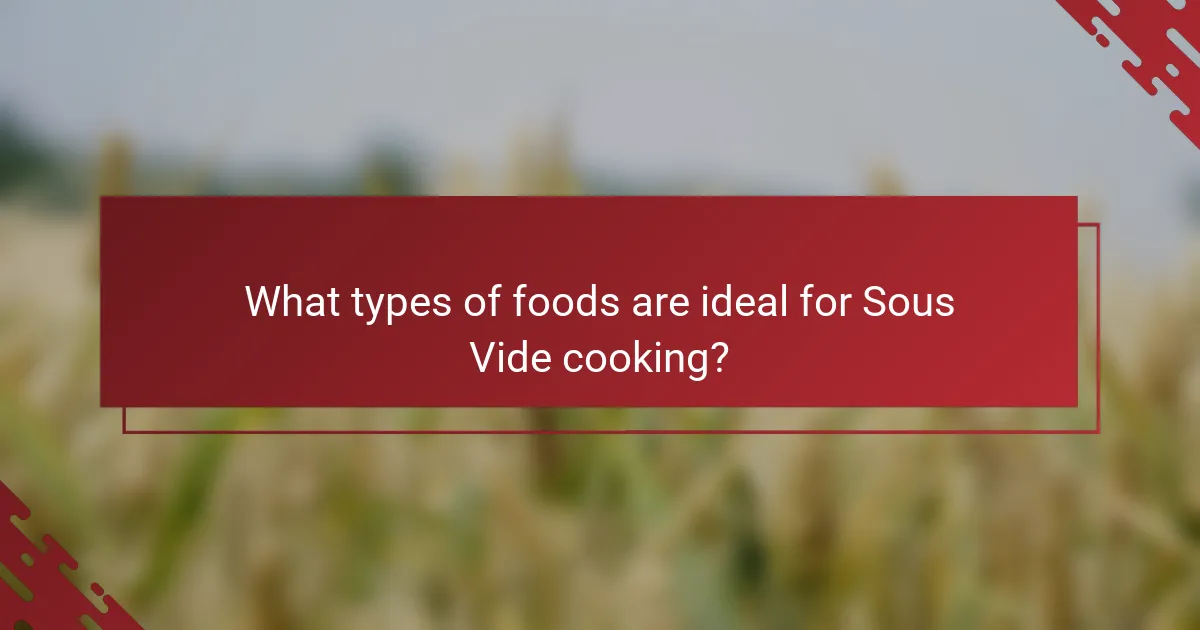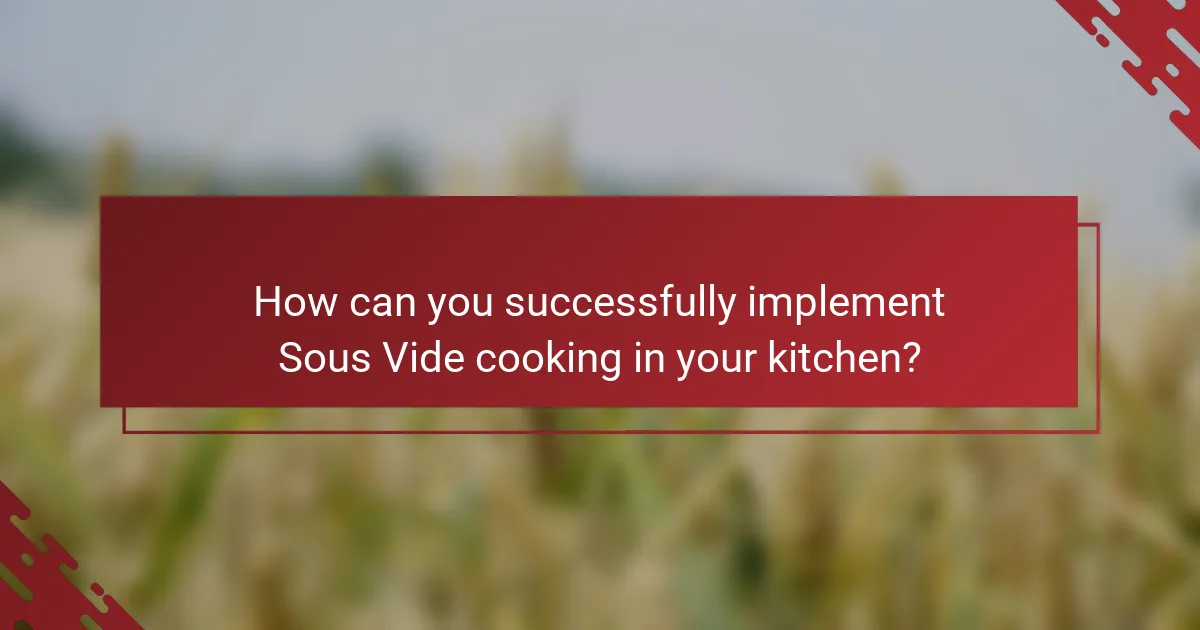Sous vide cooking techniques involve vacuum-sealing food in bags and cooking it to a precise temperature in a water bath, ensuring even cooking while retaining moisture and flavor. This method is effective for proteins like beef, pork, and chicken, as well as vegetables and eggs, enhancing tenderness and flavor retention compared to traditional cooking methods. Key components of sous vide cooking include the use of an immersion circulator for precise temperature control and vacuum-sealable bags to facilitate proper water circulation. The article will cover the benefits of sous vide, ideal foods for this technique, and practical steps for successfully implementing sous vide cooking in your kitchen.

What are Sous Vide Cooking Techniques?
Sous vide cooking techniques involve vacuum-sealing food in a bag and cooking it to a precise temperature in a water bath. This method ensures even cooking and retains moisture and flavor. Sous vide allows for precise temperature control, typically within a range of 120°F to 190°F. Cooking times can vary from one hour to several days, depending on the food type and desired doneness. This technique is popular for meats, vegetables, and eggs. Studies show that sous vide can enhance tenderness and flavor retention compared to traditional cooking methods.
How does Sous Vide cooking differ from traditional cooking methods?
Sous Vide cooking differs from traditional cooking methods primarily in its temperature control and cooking technique. Sous Vide involves sealing food in a vacuum bag and cooking it in a water bath at a precisely regulated temperature. This method allows for even cooking and retains moisture and flavor. Traditional cooking methods often rely on direct heat, which can lead to uneven cooking and moisture loss. Sous Vide can cook food for extended periods without overcooking, unlike traditional methods that may require constant attention. Research shows that Sous Vide can enhance flavor and texture, making it a preferred technique for chefs.
What is the science behind Sous Vide cooking?
Sous Vide cooking is a method that involves vacuum-sealing food in a bag and cooking it to a precise temperature in a water bath. This technique allows for even cooking and enhanced flavor retention. The science lies in the controlled temperature, which typically ranges from 130°F to 190°F. At these temperatures, proteins break down slowly, resulting in tender textures.
Cooking sous vide also minimizes moisture loss, preserving the food’s natural juices. The low-temperature environment reduces the risk of overcooking, allowing for consistent results. Research indicates that sous vide cooking can enhance the nutritional retention of food compared to traditional methods. The precise temperature control allows chefs to achieve desired doneness without sacrificing quality.
What equipment is essential for Sous Vide cooking?
The essential equipment for Sous Vide cooking includes a sous vide immersion circulator and vacuum sealer. The immersion circulator maintains a precise water temperature for even cooking. A vacuum sealer removes air from bags, ensuring food is submerged. Additionally, food-grade bags or jars are necessary for holding the ingredients. A large pot or container is needed to hold the water bath. Using these tools allows for consistent and safe cooking results. Studies show that sous vide cooking can enhance flavor and tenderness in foods.
What are the advantages of using Sous Vide cooking techniques?
Sous Vide cooking techniques offer precise temperature control, ensuring consistent results. This method allows food to cook evenly, preventing overcooking. Sous Vide retains moisture, enhancing flavor and texture. It also allows for meal prep flexibility, as food can remain in the water bath for extended periods without losing quality. Additionally, Sous Vide can enhance tenderness in tougher cuts of meat. This technique promotes better nutrient retention compared to traditional cooking methods. Studies show that Sous Vide can preserve vitamins and minerals effectively. Overall, these advantages make Sous Vide a popular choice among chefs and home cooks alike.
How does Sous Vide cooking enhance flavor and texture?
Sous Vide cooking enhances flavor and texture by cooking food in a vacuum-sealed bag at precise temperatures. This method allows for even cooking, preventing overcooking and retaining moisture. The low and slow cooking process helps break down collagen in tough cuts of meat, resulting in tender textures. Additionally, the vacuum seal traps juices and flavors, intensifying the overall taste. According to research, Sous Vide can increase flavor retention by up to 30% compared to traditional cooking methods. This technique also allows for the infusion of herbs and spices, creating more complex flavor profiles.
What safety benefits does Sous Vide cooking provide?
Sous Vide cooking provides enhanced food safety by ensuring precise temperature control. This method cooks food evenly at low temperatures for extended periods. Cooking at these controlled temperatures can eliminate harmful bacteria. For example, cooking chicken at 165°F for one hour effectively kills Salmonella. Sous Vide also minimizes the risk of cross-contamination. Vacuum sealing prevents exposure to air and pathogens. Additionally, the low cooking temperatures reduce the chances of overcooking, which can compromise food safety. Overall, Sous Vide cooking significantly reduces foodborne illness risks.

What types of foods are ideal for Sous Vide cooking?
Proteins, vegetables, and eggs are ideal for Sous Vide cooking. Proteins such as beef, pork, and chicken retain moisture and flavor when cooked sous vide. The method allows for precise temperature control, resulting in tender and evenly cooked meats. Vegetables like carrots and asparagus maintain their nutrients and vibrant colors. Sous vide cooking enhances their natural flavors without overcooking. Eggs cooked sous vide achieve a creamy texture and perfect doneness. This technique is versatile and can be used for a variety of foods to enhance taste and quality.
How do different foods react to Sous Vide cooking?
Different foods react uniquely to Sous Vide cooking. Proteins like meat and fish tenderize effectively due to low, consistent temperatures. For example, beef cooked at 131°F for 24 hours becomes exceptionally tender. Vegetables retain their color and nutrients when cooked at lower temperatures, such as carrots at 183°F for one hour. Eggs achieve a custard-like texture when cooked at 167°F for 13 minutes.
However, some foods, like leafy greens, may not respond as well due to their high water content. Cooking times and temperatures are crucial for achieving desired results. Overcooking can lead to undesirable textures, especially in delicate items like seafood.
Sous Vide cooking allows precise control over doneness. This method enhances flavors and maintains moisture across various food types. The versatility of Sous Vide makes it suitable for a wide range of ingredients.
What are the best meats for Sous Vide cooking?
The best meats for Sous Vide cooking include beef, pork, chicken, and lamb. Beef cuts like ribeye and tenderloin are ideal due to their tenderness and flavor. Pork loin and pork belly also benefit from the precise temperature control of Sous Vide. Chicken breasts remain juicy and tender when cooked Sous Vide. Lamb shanks and racks provide rich flavors that enhance through this cooking method. These meats achieve consistent doneness and enhanced flavors, making them popular choices for Sous Vide cooking.
Which vegetables thrive in Sous Vide cooking?
Vegetables that thrive in Sous Vide cooking include carrots, asparagus, potatoes, and beets. Sous Vide allows for precise temperature control, enhancing flavors and textures. Carrots become tender and retain their sweetness at 183°F for 1 to 2 hours. Asparagus cooks to a perfect crisp-tender state at 180°F for 10 to 15 minutes. Potatoes achieve a creamy texture when cooked at 185°F for 1 to 2 hours. Beets can be cooked at 185°F for 1 to 2 hours, resulting in deep, rich flavors. These cooking times and temperatures ensure optimal results for each vegetable.
What are the recommended cooking times and temperatures for Sous Vide?
Sous vide cooking requires precise temperatures and times for optimal results. Commonly recommended temperatures range from 130°F to 185°F (54°C to 85°C). For example, cooking steak typically takes 1 to 4 hours at 130°F (54°C) for medium-rare. Chicken breast often requires 1 to 2 hours at 140°F (60°C). Pork chops are best cooked at 140°F (60°C) for 1 to 4 hours. Vegetables vary, with most needing 30 minutes to 1 hour at 183°F (84°C). These guidelines ensure food safety and desired texture. Cooking times can be adjusted based on thickness and personal preference.
How do cooking times vary for different food types?
Cooking times vary significantly based on the type of food being prepared. Proteins like chicken breasts generally require 1 to 2 hours at 140°F to 165°F. In contrast, tougher cuts of meat, such as brisket, can take 24 to 48 hours at 135°F to 155°F for optimal tenderness. Vegetables typically cook faster, with times ranging from 30 minutes to 1 hour at 183°F to 185°F, depending on the type. Eggs can be cooked at lower temperatures, often around 145°F for 1 hour. Seafood, such as salmon, usually requires 45 minutes to 1 hour at 125°F to 140°F. These variations are influenced by the food’s density, fat content, and desired texture. Understanding these differences is crucial for effective sous vide cooking.
What are the ideal temperature settings for Sous Vide cooking?
The ideal temperature settings for Sous Vide cooking vary based on the type of food being prepared. For tender cuts of beef, a temperature range of 129°F to 134°F is recommended for medium-rare results. Poultry, such as chicken, should be cooked at 140°F to ensure safety while maintaining juiciness. For pork, a temperature of 145°F is ideal for achieving a tender texture. Vegetables typically require temperatures around 183°F for optimal tenderness and flavor. These temperatures allow for precise cooking, ensuring food safety while enhancing the overall dining experience.

How can you successfully implement Sous Vide cooking in your kitchen?
To successfully implement Sous Vide cooking in your kitchen, start by acquiring a Sous Vide immersion circulator. This device heats water to a precise temperature for cooking food evenly. Next, choose vacuum-sealable bags to ensure proper water circulation around the food. Seal the food in the bags, removing as much air as possible to prevent floating. Set the immersion circulator to the desired cooking temperature and time based on the specific food type. For example, cooking steak typically requires a temperature of 130°F for medium-rare. Once the water reaches the target temperature, submerge the sealed bags and cook for the recommended duration. After cooking, sear the food briefly in a hot pan for enhanced flavor and texture. This method retains moisture and enhances taste, making it a popular choice among chefs.
What tips can help beginners with Sous Vide cooking?
Start with a reliable sous vide immersion circulator. This device maintains consistent water temperatures. Choose a temperature based on the type of food you are cooking. For example, 130°F is ideal for medium-rare steak. Use vacuum-sealed bags to prevent water from entering. This ensures even cooking and retains flavors. Preheat the water bath before adding food. Cooking times can vary; consult guides for specific foods. Finally, finish with a quick sear for enhanced texture and flavor.
How can you avoid common mistakes in Sous Vide cooking?
To avoid common mistakes in Sous Vide cooking, ensure proper temperature settings. Use accurate sous vide equipment to maintain consistent temperatures. Cooking at the right temperature is crucial for food safety and quality. Avoid overcrowding the water bath, as this can lead to uneven cooking. Ensure food is properly sealed in vacuum bags to prevent water from entering. Cooking times should be adhered to for optimal texture and flavor. Use a reliable timer to avoid overcooking. Lastly, always allow for proper resting time after cooking to enhance flavors.
What are some popular Sous Vide recipes to try?
Some popular Sous Vide recipes to try include steak, chicken breast, and eggs. Sous Vide steak is cooked at a precise temperature for optimal tenderness. Cooking chicken breast Sous Vide results in juicy and flavorful meat. Sous Vide eggs can be prepared to achieve different textures, such as soft or hard-boiled. Other popular options are vegetables like carrots and potatoes, which retain nutrients and flavors. Each recipe benefits from the controlled cooking environment that Sous Vide provides. This method ensures consistent results and enhances the overall dining experience.
How can you customize Sous Vide recipes for personal taste?
You can customize Sous Vide recipes for personal taste by adjusting seasonings, cooking times, and temperature settings. Start by experimenting with different herbs and spices to enhance flavors. For instance, adding garlic or rosemary can significantly change the dish’s profile. Adjusting cooking times allows for varying textures; longer times can yield more tender results. Additionally, modifying the temperature can influence doneness; lower temperatures result in more rare meat, while higher temperatures yield well-done. Personal preferences should guide these adjustments. Taste testing during the process can help refine the final outcome. This flexibility is a key advantage of Sous Vide cooking, allowing for tailored culinary experiences.
Sous Vide cooking techniques involve vacuum-sealing food and cooking it in a water bath at precise temperatures, enhancing tenderness and flavor retention. This method differs from traditional cooking by ensuring even cooking and minimizing moisture loss, making it ideal for proteins, vegetables, and eggs. Essential equipment includes a sous vide immersion circulator and vacuum sealer, while the advantages of sous vide include meal prep flexibility and improved nutrient retention. The article covers the science behind sous vide, recommended cooking times and temperatures, food safety benefits, and tips for successful implementation, along with popular recipes and customization options for personal taste.